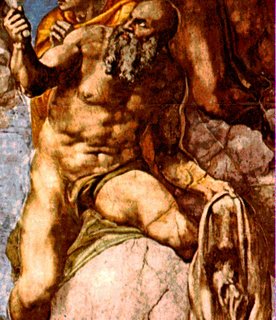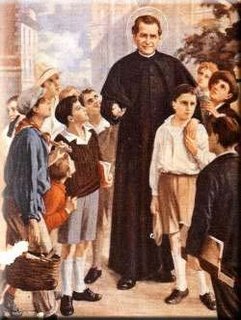December 27
JOHN, the brother of Saint James the Greater, was a son of Zebedee, a fisherman of Galilee, and of Salome, a cousin of the Blessed Virgin Mary (Matthew 4:21). He was the youngest of the apostles, and, with Peter and James, was the most trusted of the disciples of Jesus, by Whom he was most tenderly loved, on which account he is called the Disciple of Love. Of this Jesus gave the most convincing evidence when, at the Last Supper, He allowed that disciple to lean upon His breast, and when, from the cross, He committed to the care of John His own Mother. After the ascension John preached the Gospel in Palestine; afterwards went to Asia Minor, fixed his residence in Ephesus, and established many churches there. He was, with the other apostles, taken prisoner and scourged by the Jews, and in the year 95, under the Emperor Domitian, before the Latin Gate, at Rome, was thrown into a vessel of boiling oil. Having endured this torture without injury, he was then banished to the island of Patmos, where, by command of the Lord, he wrote the Apocalypse, or Revelation, concerning the fortunes of the Church. On returning from hIs banishment he again governed the churches of Asia Minor as chief pastor, as he had done before, and, at the age of nearly one hundred years, died at Ephesus a peaceful and natural death.
The Introit of the Mass reads: "In the midst of the Church the Lord opened his mouth, and filled him with the spirit of wisdom and understanding, and clothed him with a robe of glory. It is good to give praise to the Lord, and to sing to Thy name, O Most High." Glory be to the Father, and to the Son, and to the Holy Spirit, Amen. As it was in the beginning, is now, and ever shall be, world without end. Amen.
Prayer
Mercifully illustrate Thy Church, O Lord, that, enlightened by the doctrines of Thy blessed apostle and evangelist Saint John, she may arrive at gifts everlasting. Through Christ our Lord, etc. Amen.
Epistle: Ecclesiasticus 15:1-6
He that feareth God will do good: and he that possesseth justice shall lay hold on her, and she will meet him as an honorable mother, and will receive him as a wife married of a virgin. With the bread of life and understanding, she shall feed him and give him the water of wholesome wisdom to drink; and she shall be made strong in him, and he shall not be moved; and she shall hold him fast, and he shall not be confounded; and she shall exalt him among his neighbors, and in the midst of the Church she shall open his mouth, and shall fill him with the spirit of wisdom and understanding, and shall clothe him with a robe of glory. She shall heap upon him a treasure of joy and gladness, and our Lord God shall cause him to inherit an everlasting name.
On Purity
"He that loves wisdom," saith the Holy Ghost, "will obtain it, for it will not enter into a malicious soul, nor dwell in a body subject to sins" (Wisdom 1:4). Saint John was from his childhood an angel of purity, on which account he was particularly beloved by Jesus, and endowed by the Holy Ghost with such wisdom and knowledge that, as Saint Augustine has remarked, he begins his gospel in a manner more lofty and sublime than the other three evangelists. For while they walk with the God-man upon earth, speaking comparatively little of His divinity, Saint John, as if despising the world, soars beyond the vault of heaven, above the hosts of angels, and comes to Him by Whom all things are made, saying, "In the beginning was the Word." At the Last Supper he was permitted to lean on the bosom of Jesus, but what he there drank in secretly he imparted openly. Apply thyself, therefore, to purity of heart, and thou shalt be like Saint John, a beloved disciple of Jesus, and shalt be filled with heavenly wisdom.
Gospel: John 21:19-24
At that time Jesus said to Peter: Follow Me. Peter turning about, saw that disciple whom Jesus loved following, who also leaned on His breast at supper, and said: Lord, who is he that shall betray Thee? Him therefore when Peter had seen, he saith to Jesus: Lord, and what shall this man do? Jesus saith to him: So I will have him to remain till I come, what is it to thee? follow thou Me. This saying therefore went abroad among the brethren, that that disciple should not die. And Jesus did not say to him: He should not die; but, So I will have him to remain till I come, what is it to thee? This is that disciple who giveth testimony of these things, and hath written these things; and we know that his testimony is true.
JOHN, the brother of Saint James the Greater, was a son of Zebedee, a fisherman of Galilee, and of Salome, a cousin of the Blessed Virgin Mary (Matthew 4:21). He was the youngest of the apostles, and, with Peter and James, was the most trusted of the disciples of Jesus, by Whom he was most tenderly loved, on which account he is called the Disciple of Love. Of this Jesus gave the most convincing evidence when, at the Last Supper, He allowed that disciple to lean upon His breast, and when, from the cross, He committed to the care of John His own Mother. After the ascension John preached the Gospel in Palestine; afterwards went to Asia Minor, fixed his residence in Ephesus, and established many churches there. He was, with the other apostles, taken prisoner and scourged by the Jews, and in the year 95, under the Emperor Domitian, before the Latin Gate, at Rome, was thrown into a vessel of boiling oil. Having endured this torture without injury, he was then banished to the island of Patmos, where, by command of the Lord, he wrote the Apocalypse, or Revelation, concerning the fortunes of the Church. On returning from hIs banishment he again governed the churches of Asia Minor as chief pastor, as he had done before, and, at the age of nearly one hundred years, died at Ephesus a peaceful and natural death.
The Introit of the Mass reads: "In the midst of the Church the Lord opened his mouth, and filled him with the spirit of wisdom and understanding, and clothed him with a robe of glory. It is good to give praise to the Lord, and to sing to Thy name, O Most High." Glory be to the Father, and to the Son, and to the Holy Spirit, Amen. As it was in the beginning, is now, and ever shall be, world without end. Amen.
Prayer
Mercifully illustrate Thy Church, O Lord, that, enlightened by the doctrines of Thy blessed apostle and evangelist Saint John, she may arrive at gifts everlasting. Through Christ our Lord, etc. Amen.
Epistle: Ecclesiasticus 15:1-6
He that feareth God will do good: and he that possesseth justice shall lay hold on her, and she will meet him as an honorable mother, and will receive him as a wife married of a virgin. With the bread of life and understanding, she shall feed him and give him the water of wholesome wisdom to drink; and she shall be made strong in him, and he shall not be moved; and she shall hold him fast, and he shall not be confounded; and she shall exalt him among his neighbors, and in the midst of the Church she shall open his mouth, and shall fill him with the spirit of wisdom and understanding, and shall clothe him with a robe of glory. She shall heap upon him a treasure of joy and gladness, and our Lord God shall cause him to inherit an everlasting name.
On Purity
"He that loves wisdom," saith the Holy Ghost, "will obtain it, for it will not enter into a malicious soul, nor dwell in a body subject to sins" (Wisdom 1:4). Saint John was from his childhood an angel of purity, on which account he was particularly beloved by Jesus, and endowed by the Holy Ghost with such wisdom and knowledge that, as Saint Augustine has remarked, he begins his gospel in a manner more lofty and sublime than the other three evangelists. For while they walk with the God-man upon earth, speaking comparatively little of His divinity, Saint John, as if despising the world, soars beyond the vault of heaven, above the hosts of angels, and comes to Him by Whom all things are made, saying, "In the beginning was the Word." At the Last Supper he was permitted to lean on the bosom of Jesus, but what he there drank in secretly he imparted openly. Apply thyself, therefore, to purity of heart, and thou shalt be like Saint John, a beloved disciple of Jesus, and shalt be filled with heavenly wisdom.
Gospel: John 21:19-24
At that time Jesus said to Peter: Follow Me. Peter turning about, saw that disciple whom Jesus loved following, who also leaned on His breast at supper, and said: Lord, who is he that shall betray Thee? Him therefore when Peter had seen, he saith to Jesus: Lord, and what shall this man do? Jesus saith to him: So I will have him to remain till I come, what is it to thee? follow thou Me. This saying therefore went abroad among the brethren, that that disciple should not die. And Jesus did not say to him: He should not die; but, So I will have him to remain till I come, what is it to thee? This is that disciple who giveth testimony of these things, and hath written these things; and we know that his testimony is true.
– Goffine's Devout Instructions
















